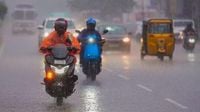As India’s summer monsoon season hits its stride, two of the nation’s largest urban centers—Delhi and Chennai—have found themselves at the mercy of heavy rains, thunderstorms, and the disruptions they bring. Over the past several days, residents of both cities have experienced a dramatic shift in weather, with rainfall offering much-needed relief from oppressive humidity, even as it introduces new challenges of its own.
On August 23, 2025, the India Meteorological Department (IMD) issued a red alert for Delhi and the wider National Capital Region (NCR). According to India Today, this urgent warning came as showers swept across the city on Saturday afternoon, providing a welcome break from the relentless heat and humidity that had gripped the area. The IMD’s updated nowcast map indicated that Delhi, South Haryana, East Rajasthan, and North Gujarat were all likely to receive moderate to heavy rainfall over the following three hours—a forecast that proved accurate as rain continued into the evening.
Delhi’s rainfall touched nearly every corner of the city, with north, central, south, and southeast districts all reporting showers. The IMD specifically highlighted areas such as Civil Lines, Red Fort, Lajpat Nagar, Narela, Bawana, Alipur, and ITO as likely to see continued rainfall, gusty winds, and even lightning through Saturday evening and into Sunday. The maximum temperature in Delhi on August 23 dropped to 34.5 degrees Celsius—slightly below the seasonal average—while the minimum settled at 25.7 degrees Celsius. Humidity, however, remained high, reaching 76 percent around 5:30 pm.
Despite the intensity of the downpour, the city’s infrastructure showed signs of resilience. The Public Works Department’s flood control room received around 10 complaints of waterlogging during the day, but most were resolved within an hour, according to a report from PTI. For a city that often makes headlines for its struggles with monsoon flooding, this was a rare moment of efficiency. The IMD, however, cautioned residents to remain vigilant, as the wet spell was expected to persist at least through Sunday.
One unexpected upside to the rain was a notable improvement in Delhi’s air quality. The Central Pollution Control Board recorded an Air Quality Index (AQI) of 93 at 6 pm on August 23, placing the city firmly in the “satisfactory” range. For context, an AQI between 51 and 100 is considered satisfactory, while readings up to 50 are classified as good. This drop in pollution levels, albeit temporary, was a breath of fresh air—quite literally—for Delhiites accustomed to far worse.
Meanwhile, more than 2,000 kilometers to the south, Chennai was experiencing its own meteorological drama. As Times Now reported, the city woke up on August 23 to a rain-soaked morning, marking the second consecutive day of heavy showers. The downpour brought immediate relief from the city’s notorious humidity, but it also led to waterlogging in several low-lying neighborhoods, prompting local authorities to issue advisories and urge caution, especially during the evening hours when thunderstorms and lightning were most likely.
Meteorologists noted that this was the first widespread thunderstorm event of the 2025 southwest monsoon season for North Coastal Tamil Nadu. The Kancheepuram–Tiruvallur–Chennai–Chengalpattu (KTCC) belt, which includes Chennai and its sprawling suburbs, saw strong showers across virtually every area on August 22 and 23. According to a popular weather forecaster known as Chennai Rains, the action was expected to gradually shift towards the Delta districts and adjoining pockets of North and South Tamil Nadu later in the day. Residents in these regions were warned to prepare for moderate to intense thunderstorms, gusty winds, and lightning in the evening and night hours.
While Friday’s forecast called for continued moderate rain or thunderstorms with lightning, meteorologists predicted that rainfall would start to decrease across most of Tamil Nadu from August 24 onward. Chennai’s seven-day outlook, starting August 23, called for partly cloudy skies with occasional drizzle or light rain through the weekend, and temperatures climbing as high as 36 degrees Celsius in the coming week. By midweek, showers were expected to become lighter and less widespread, eventually tapering off to mere drizzle.
As Chennai’s residents navigated flooded streets and braced for further storms, authorities reminded people to stay indoors during evening thunderstorms and to heed lightning warnings. The city’s experience with waterlogging underscored the persistent challenges of urban drainage during monsoon season—a problem shared by many Indian cities, where rapid urbanization often outpaces infrastructure improvements.
For both Delhi and Chennai, the recent rains have been a double-edged sword. On one hand, the showers have brought a reprieve from sweltering summer conditions, lowering temperatures and temporarily improving air quality. On the other, they have exposed vulnerabilities in urban planning, as even brief but intense rainfall can overwhelm drainage systems and create hazardous conditions for commuters and residents alike.
Looking ahead, the IMD’s advisories for both cities stress the need for ongoing vigilance. In Delhi, the wet spell is expected to continue, with the possibility of further thunderstorms and gusty winds in the coming days. Chennai, meanwhile, is likely to see a gradual reduction in rainfall, but authorities remain on alert for localized flooding and electrical hazards associated with thunderstorms.
“Updated nowcast map for heavy rainfall over red-coloured districts including Delhi, South Haryana, East Rajasthan, North Gujarat during the next 3 hours,” the IMD posted in a tweet, highlighting the dynamic and rapidly evolving nature of the monsoon season. In Chennai, weather experts have emphasized the rarity of such a widespread thunderstorm event this early in the season, noting that “almost every area in the Kancheepuram–Tiruvallur–Chennai–Chengalpattu belt witnessed strong showers.”
The monsoon, often described as both a blessing and a curse for India, continues to shape daily life in the subcontinent’s major cities. While the rains bring much-needed relief and replenish water supplies, they also serve as a stark reminder of the need for resilient infrastructure and effective disaster preparedness. As Delhi and Chennai weather the latest storms, residents and officials alike are left hoping for a balance between nature’s bounty and its challenges.
